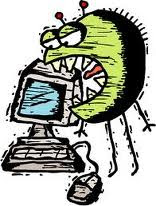
One of the most difficult things to detect on a computer is a virus threat or attack, because these come in so many different forms. You should always keep your anti-virus up to date and make sure that it is working. Besides an anti-virus, you should also have some type of spy-ware program installed. If you have both of these, then you never really have to panic over a virus attack, but you always want to be aware of strange computer behavior, emails and strange pop-up windows.
Instructions
Look for strange emails or strange computer behavior like error messages, computer shutdown or freezing right after you open an email from someone you don't know. Immediately run your antiviral program, as the email may have infected your computer with a virus.
Check to see if your anti-viral software is up to date and turned on. Look on the lower right-hand corner of the bottom Windows toolbar for your anti-virus icon. Move your cursor over all the icons, and the names will appear. If your anti-virus name does not appear, then you may not have an anti-virus or a threat may have disabled the virus. Go to "Start" and "All Programs" and locate your anti-virus. Click on the icon twice to open it and scan your C: drive to see if your computer has been infected. However, just because your anti-virus cannot detect a virus does not mean you don't have one. Update your anti-virus and run it again, or run an online anti-virus scan from Trend Micro, Freebyte or Avast (See Resources).
Check your Explorer toolbar to see if additional icons have been added, or if your home Web page has changed automatically. Notice the amount of advertisements or pop-up windows you are getting. If advertising websites show up for no apparent reason, without your even clicking on anything, then you have been infected by mal-ware. These are signs of mal-ware threats. Download a spy-ware program like Ad-ware BOT, No AdWare or Error Scan and Fix (See Resources).
Remain on guard for strange security messages from software companies you have not bought products from. Be aware of security messages warning you of fake viruses. These are balloon-like messages that tell you your computer is infected, and that you must purchase a certain program to remove it. These are threats that masquerade as Microsoft messages. Remember, if your anti-virus is on, and up to date, then it should catch a real virus. Close the fake virus window and surf on other windows. Look for other Windows error messages, blue screens or freezing as indications of real virus threats.
Read more: http://goo.gl/iQJ4k
0 comments:
Post a Comment